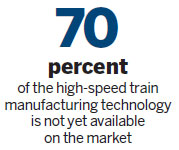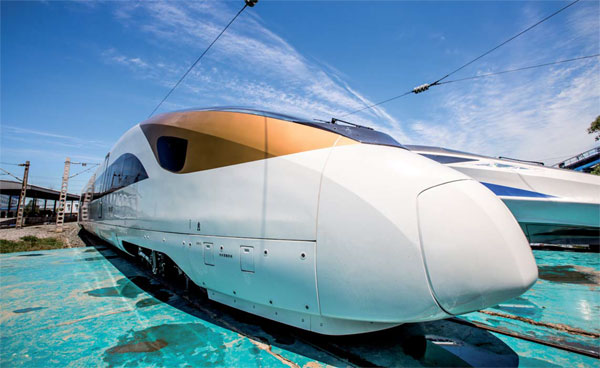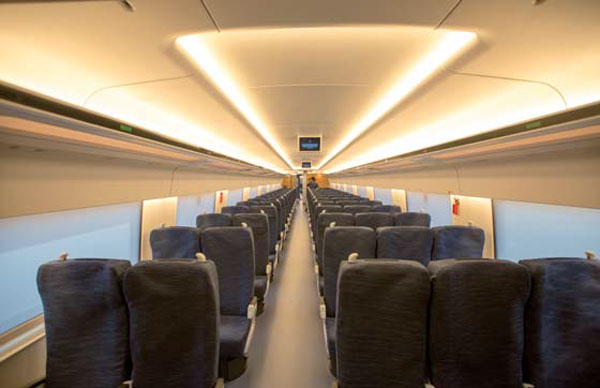A vital link in high-speed growth

UK's HS2 project may offer foothold to Chinese rail industry
The UK's new high-speed railway project, High Speed 2, could be a good opportunity to help the fast-growing Chinese railway industry gain a foothold in developed markets, experts say.
Although official bidding for HS2 hasn't yet started, it is believed that China's largest maker of rolling stock, China Railway Rolling Stock Corp, is a promising candidate, given its extensive experience accumulated through building thousands of miles of high-speed rail in China.
| China Railway Rolling Stock Corp is a promising candidate for the UK's high-speed railway project, High Speed 2. Photos provided to China Daily |
| Inside a Chinese high-speed train. |
CRRC has yet to confirm its intention to bid for HS2, but in May it demonstrated commitment to the UK market by opening a subsidiary and a research and development center in cooperation with three British universities.
James Jameson, vice-president of product strategy at Rivo, a British company that supplies safety software to the rail industry, says Chinese railway technology has the unique advantage of being cost effective.
He says cost-saving techniques have been accumulated through experience and the Chinese high-speed railway industry's economies of scale, and they can bring great benefits to the UK.
"The cost-saving comes from the actual trains, the knowledge and the massive economy of scale. The Chinese firms have technology that's developed over the years, which is tried, tested, improved and highly valuable," he says.
The UK government is planning HS2 in two phases. The first phase, which links London and Birmingham, will start construction in 2017 with an indicated opening date of 2026 and government-estimated cost of 22 billion pounds.
This will be followed by phase two, an extension to Manchester and Leeds opening by 2033. Other companies which that expressed interest include France's Alstom, Siemens AG of Germany and Japan's Hitachi Ltd.
In addition to HS2, once Chinese railway firms localize their railway technology in the United Kingdom, they can build up these economies of scale for further exports to Europe, Jameson says.
"There are great opportunities for Chinese railway firms to further expand into Europe. Apart from the UK's extension of its high-speed rail network, Europe has plans to triple its high-speed rail by 2030," Jameson says.
He says Chinese railway firms can apply their technology to other railway projects in the UK and Europe, as there are great amounts of transferable technology between high-speed trains and other projects, such as Britain's Crossrail Two. Examples of transferable skills include the signaling of the trains system and the laying of the tracks, he says.
"It doesn't have to stop at high-speed rail, there are other major rail infrastructure projects where skills and technologies can be transferable. However, in addition to having great technology and cost advantage, Chinese railway firms also need to demonstrate that they are willing to invest in the UK economy in order to win significant parts of projects such as HS2."
Jameson says for Chinese railway firms to win UK projects, it is important for them to create local employment.
It also makes sense for Chinese railway firms to work with UK partners, because the UK has great advantage in specific railway technology, such as signaling and railway digital communication, and these components in the high-speed train supply chain are exported all over the world, he says.
China's high-speed train technology started to develop in 2004, initially through studying the technology of high-speed trains in Japan, France and Germany, and then engaging in self-initiated R&D.
This development followed the strategic direction proposed by China's State Council, which proposed introducing advanced technology, combining design and production, to create a Chinese brand.
One key advantage of the Chinese high-speed trains system is its adaptability to different climates and environments, because China's varied landscape has forced firms like CRRC to produce resilient products.
For example, CRRC trains can run in all landscapes, including plain, mountain, alpine, plateau and sandy areas. They can withstand hot climates of 40 to 45 C, but simultaneously function perfectly in a temperature of minus -40 to -45 C.

CRRC's high-speed trains have also broken world records on several occasions, for example, the 2,298-km Beijing-Guangzhou line is the longest in the world. CRRC has also recorded the largest delivery quantities of high-speed trains globally, having delivered 950 high-speed trains as of April.
Russell Jackson, market director of emerging markets, transportation, at engineering consultancy Atkins, says the costs per kilometer of Chinese high-speed railways are very competitive when compared with the UK.
"I expect the technology is comparable to the UK, as it's clear the Chinese rail industry has built a vast high-speed network in the time the UK has spent between building HS1 and designing HS2 - that is an unrivalled experience and capability in high-speed railway engineering.
"However, it is important for Chinese railway firms to understand the differences between Chinese and UK environments when looking to bring their experience to benefit UK projects," Jackson says.
"The UK's challenges are around building the line in urban and semi-urban environments, and in rural areas where the public hold environmental protection as a tough balance against the new railway's benefits."
Qiu Yi, an associate professor at the University of Southampton who focuses on sound and vibration research for public transport, says Chinese high-speed trains are on a par with global standards for their hardware, but still lag behind overseas competitors for some software such as safety and comfort levels.
"After all, the main leading high-speed train companies globally all have the sufficient technology for the trains to achieve the desired functions, safety and comfort are the next level of competition," says Qiu. "This is especially the case in Europe as comfort and customer experience are seen as so important in Europe's transport industry."
Because of the fast growth of China's high-speed train industry, and the demand for high-quantity systems, Chinese companies have not historically placed much focus on comfort in relation to vibration and noise, but this situation is now changing as passengers demand more comfort.
To help CRRC improve its train comfort, the Institute of Sound and Vibration Research at the University of Southampton started two cooperation projects with the CRRC team last year, one focusing on active noise control and the other focusing on sound quality.
Active noise control is a technology that reduces unwanted sound by the addition of a second-sound specifically designed to cancel the noise. Sound quality technology assesses the accuracy, enjoyability or intelligibility of audio output or sound using both objective and subjective methods.
Qiu says although some of this technology has been applied in the West in the car and aviation industries, it has not yet been applied to the high-speed train industry, and cooperation with CRRC can help them take a lead.
Now that the University of Southampton has become a part of the CRRC research center in the UK, Qiu's team is currently working with CRRC to set up a collaborative research project on active noise control seat and ride comfort.
The University of Southampton is one of the three British universities, alongside Imperial College London and the University of Birmingham, partnering the CRRC on railway research at its UK R&D center launched in May. The R&D work will both improve CRRC's overall technology and also help it to develop technology for international expansion.
CRRC and Imperial College London have established an R&D project for modern manufacturing process of high-speed trains, with the intention of improving manufacturing efficiency and reducing costs.
"High-speed rail manufacturing in China is already very efficient and cost-effective, but it is relatively labor intensive, and hopefully with the new research collaboration with us it can become more capital-intensive," says Roderick Smith, a research professor at the Future Rail Research Centre of Imperial College London.
Smith says some of this R&D work may focus on innovative modern manufacturing methods, including novel methods of forming metals that can cope with complex shapes of high-speed trains. Also, it can explore the field of automated manufacturing methods that have advantages for mechanical behavior and aerodynamics, he says.
About 70 percent of this high-speed train manufacturing technology is not yet available on the market, as they are being developed in laboratory conditions, so it may give CRRC a big advantage. The remaining 30 percent of technology already exists in the market, and will be applied to CRRC's production line.
Smith says Chinese high-speed railway companies have great cost advantages, mainly derived from three aspects, which are the economy of scale in the manufacturing process, the lower labor market costs and the fast decision-making process of the Chinese government. "The decision-making process concerning high speed trains is actually a huge cost in Western countries," he says.
In addition to collaboration with British universities, CRRC is also working with the British company PriestmanGoode on train design, through its subsidiary CSR Sifang.
PriestmanGoode has been collaborating with CSR Sifang's in-house design and engineering teams since 2008 on the design of high-speed trains and metro trains. Paul Priestman, director of PriestmanGoode, has also been appointed global creative Director of CSR Sifang.
In the partnership, PriestmanGoode will help with the design of new high-speed trains, which give consideration to both aesthetic aspects like colors and the luxury feel of the interior, and also functions including installing hot water dispensers on trains and allowing the seats to swivel so the travelers never face backwards.
Priestman says his team will take into consideration technology, to make sure it will easily accommodate new ideas as they are 4 developed.
For example, trains now have many more advertisements on screens than do aircraft, where more and more passengers are using tablets and phones. So in the future advertising may shift to advertising on windows when the technology makes that possible.
"We are aware of (such potential technology), we research it, and we understand what possible requirements would be. For window displays, we would need to get power to the glass, so we allow space for electric cables in the design today. It's future proofing."
Priestman says he believes CRRC's technology is hugely competitive compared with European equivalents. "The scale of their manufacturing capabilities is a great advantage. I also think that we can learn a lot from their design process, which is a much more multi-track approach than we operate in the West."
"They develop many solutions simultaneously and pick the best option once they are quite far developed. This approach often results in a speedier resolution to the development process and a great end product," Priestman says.
In addition, other infrastructure projects linked to the HS2 project can also provide Chinese construction companies with opportunities to expand into the UK, says Richard Marshall, an infrastructure analyst at BMI Research.
These projects involve regional transport networks in areas surrounding the HS2 trains, and the associated tunnels and bridges, he says.
"HS2 is just a single high speed train that runs across the country, but there are many other supporting infrastructure needed to maximize HS2's benefit to the UK's regional economy," Marshall says.
He says although the HS2 is publicly funded, much of the supporting infrastructure requires private sector investment, and Chinese construction companies' ability to secure funding from Chinese financiers would give them an advantage in bidding for these deals.
These HS2-related infrastructure projects have a relatively high-risk profile, given how closely related their success will be to that of HS2, and it's still unclear what level of future usage these infrastructure assets will have by the UK public. Although government calculations show them to have a large demand, there is no guarantee about the accuracy of government statistics.
cecily.liu@chinadaily.com.cn
(China Daily European Weekly 08/28/2015 page14)
Today's Top News
- Japan tempting fate if it interferes in the situation of Taiwan Strait
- Stable trade ties benefit China, US
- Experts advocate increasing scope of BRI to include soft power sectors
- New engine powers cargo drone expansion
- China to boost green industry cooperation
- Manufacturing PMI rises in November
































